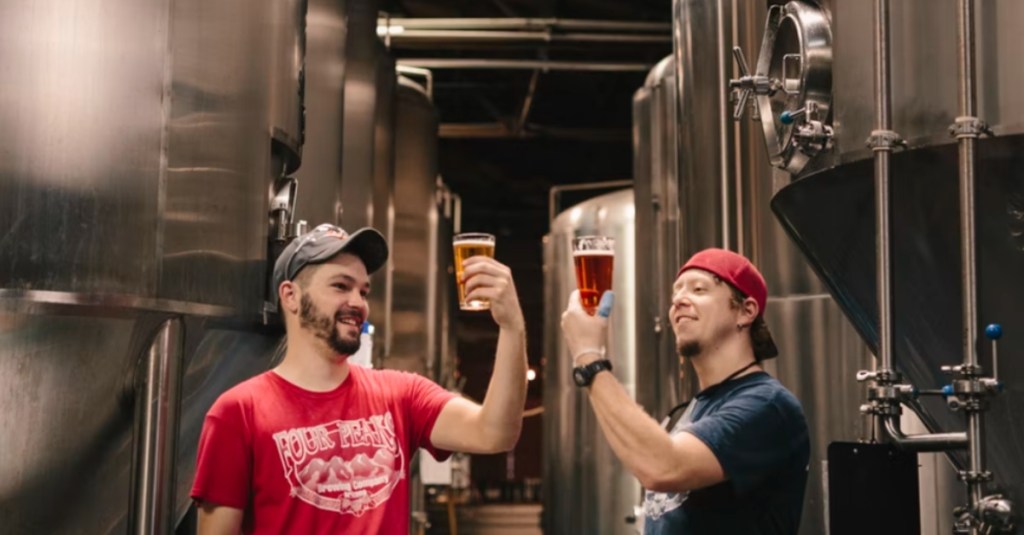If you love breweries and craft beer but the whole process is a bit lost on you, here are 8 things that go on behind the scenes to give you an insider’s view of the industry.
8. Yes, they’ll bring the beer.
Image Credit: iStock
Like most professions, if yours involves making something delicious, friends and neighbors and coworkers will be disappointed if you show up empty-handed, says Tom Kehoe, co-owner of Yards Brewing Company in Philadelphia.
“If it’s appropriate to bring beer, I will. And sometimes when it is not so appropriate.
I have brought beer to a business networking breakfast and somehow it turned out to be a great icebreaker. I find that people are disappointed if I don’t have at least some beer at the ready.”
So… find yourself some brewmaster friends!
7. Many brewmasters started out as home brewers.
Image Credit: iStock
Kehoe also reveals that while some brewmasters do have college degrees in chemistry or something similar, just as many started by tinkering at home.
“When I started, I would say about 50% were home brewers. The basic knowledge of how beer is made is exactly the same.
However, good brewing practices need to be learned on site. The environment working in a brewery is a lot different than brewing at home.”
The number of breweries has grown exponentially in recent years, and now as many as 90% of working brewmasters experimented first at home before doing it professionally.
6. They know they can be hypercritical.
Image Credit: iStock
It’s no secret that whatever you do professionally, it affects the way you view that product when it’s made by other people – which according to Stone Brewing brewmaster Jeremy Moynier, sadly means that brewmasters can struggle to enjoy drinking socially sometimes.
“I still love beer, but it changes the way you approach it. You pick out a flaw, and it will bother you. It might ruin your enjoyment.
But if you find a beer you really like, it can also make it more enjoyable.”
This pickiness can extend to flavors in foods, too, and which ones make the best pairings for the beers in their hands.
5. They use another sense almost as much as taste.
Image Credit: iStock
Most microbreweries use a lot of machinery, like stainless steel vats, pumps, and bottling lines used to create the perfect brew. According to Moynier, it’s a bit like a symphony, and if something is off, a good brewmaster can tell.
“You use all of your senses, from taste to sound. Breweries are noisy, and there are sounds you get attuned to.
If something sounds wrong, you know there’s a problem somewhere. Your senses being in tune are important.”
Once, he followed an unfamiliar squeaking noise that led him to discover a backed-up tank, helping him avoid a costly repair.
4. Names and logos are key.
Image Credit: iStock
If you’ve ever perused the craft beer aisle at the grocery store, you’ve probably wondered if there’s some kind of contest to come up with the cleverest name – and you’re not really wrong.
Marketing is key in any industry, and as more and more craft beers enter the market, helping people remember your product is key.
Tröegs’s, for example, makes a beer called Haze Charmer, and the website description goes into how they chose the unusual name.
“Haze Charmer emerges from a soft, swirling cloud of oats and unmalted wheat.
Vigorous dry-hopping adds a second phase of haze, propping up the oils of Citrus and El Dorado.”
You want people to know what they’re getting, to have the package reflect what’s in the can or bottle, and to come up with a name that sticks in the mind.
No pressure.
3. There’s no flavor they won’t try.
Image Credit: iStock
Recently I’ve seen a waffle and bacon-flavored beer, and also one that’s flavored like mustard, so the fact that Moynier says they’re offering an oyster stout doesn’t really surprise me.
“There are so many different styles, flavor, and aroma profiles you can hit.
We’re constantly learning about new ingredients.”
As for the oyster stout, Moynier called it “pretty fascinating.”
2. Color equals mood.
Image Credit: iStock
Kehoe says that light and dark beers, which result from different sorts of grains, each give off a distinctive personality trait.
“To me, the color of the beer is the mood of the beer.
Light color is fluid and exciting. Darker is slower and more filling and relaxing. Amber is more middle of the road – it can be whatever personality that you want to project in the moment.”
Color me intrigued!
1. Sanitation is a big part of the work.
Image Credit: iStock
Brewmasters might love coming up with new flavor profiles and dreaming up the perfect name for their latest creation, but according to John Togner, co-owner of Tröegs Independent Brewing in Hershey, Pennsylvania, the majority of their job is making sure they’re working in clean and sanitary conditions.
“People usually think you’re sitting around all day dreaming up recipes and tasting beer. That’s a very small component.
Physical cleaning is probably 80 percent of it. Sanitation is paramount.
It’s like a chef keeping a kitchen clean. Workers spend more of their time scrubbing.”
Good luck in your brewing adventures!
